
|
Sale 46
The Millennia Collection
| Lot |
Photo |
Description |
Realized |
Lot 373 |
 |
Great Britain. Pattern Gold Guinea, 1729. WR-73. S-3672. DM-45. George II, 1727-1760. Second Young Head, left, by John Croker. Reverse: Crowned and garnished shield. Plain edge. The digit "9" in the date repunched, or double-cut. A flashy brilliant Choice Proof with a moderate cameo, the best of only several seen in over two decades. Extremely rare (R5: just 6 to 10 known). With a most impressive pedigree. NGC graded Proof 63 Cameo.
Estimated Value $12,000 - 15,000.
Ex Bergne, Young, Egmont-Belber, Moon, Bliss, Brand, Norweb, and Dr Jacob Y. Terner collections.
View details and enlarged photos
| Realized
$20,125 |
Lot 374 |
 |
Great Britain. Guinea, 1732-EIC. S-3673; Fr-340; KM-573.4. George II, 1727-1760. Second Young Head. Laureate head left, below: E.I.C. Reverse: Crowned and garnished shield. Normal-sized legends. Very rare. A beautiful, historic coin exhibiting a crisp strike and strong luster. A classic rarity, in top condition! NGC graded MS-64.
Estimated Value $9,000 - 10,000.
Ex Dr Jacob Y. Terner Collection.
View details and enlarged photos
| Realized
$17,250 |
Lot 375 |
 |
Great Britain. Crown, 1736. S-3686; ESC-121; Dav-1347; KM-575.1. NONO on edge. George II, 1727-1760. Young Head, left. Roses and plumes in the angles. Unusually choice, a beautiful Uncirculated specimen, sharply struck, well centered; considerable mint luster combines with stunning reddish-gold, violet and bluish green pastel toning to create a numismatic masterpiece of unusual eye appeal. NGC graded MS-63.
George II was son and successor to George I, and like his father he was also Prince Elector of his native Hanover. Unlike his father, he embraced being English, lived in London, spoke English, and the early years of his reign were peaceful and prosperous. This lovely coin is a marvelous memento of that period. Crowns of this type are not extremely rare even in Mint State, but seldom is one found so extraordinarily handsome as this one.
Estimated Value $2,000 - 2,500.
View details and enlarged photos
| Realized
$5,100 |
Lot 376 |
 |
Great Britain. Guinea, 1738. S-3674; Fr-339; KM-573.3. George II, 1727-1760. Second Young Laureate Head, left. Reverse: Crowned and garnished shield. Last year of this generally rare type. A choice coin with a slightly shallow portrait. Its luster is unusually strong, and it escaped the ages relatively unblemished. NGC graded MS-62.
Estimated Value $3,500 - 4,000.
Ex Dr Jacob Y. Terner Collection.
View details and enlarged photos
| Realized
$5,060 |
Lot 377 |
 |
Great Britain. Guinea, 1739-EIC. S-3677; Fr-342; KM-577.2. George II, 1727-1760. Intermediate Laureate Head, left, below: E.I.C. Reverse: Crowned and garnished shield. Long fine diebreak through bottom of obverse. A splendid coin! Glowing golden red luster. Possibly the finest known East India Company guinea! NGC graded MS-65.
Estimated Value $10,000 - 12,500.
Ex Norweb Collection. Ex Dr Jacob Y. Terner Collection.
View details and enlarged photos
| Realized
$18,975 |
Lot 378 |
 |
Great Britain. Guinea, 1739. S-3676; Fr-341; KM-577.1. George II, 1727-1760. Intermediate Laureate Head, left. Reverse: Crowned and garnished shield. Boldly struck and exceptionally choice, a lovely Uncirculated coin, rare in this grade. Diebreak through the bottom of the truncation. NGC graded MS-62.
Estimated Value $3,500 - 4,000.
Ex Dr Jacob Y. Terner Collection.
View details and enlarged photos
| Realized
$5,290 |
Lot 379 |
 |
Great Britain. Guinea, 1740. S-3676; Fr-341; KM-577.1. George II, 1727-1760. Intermediate Laureate Head, left. Reverse: Crowned and garnished shield. A rarely seen date in remarkable grade. Uncirculated and remarkably unblemished, with flashy luster. NGC graded MS-62.
Estimated Value $3,500 - 4,000.
Ex Dr Jacob Y. Terner Collection.
View details and enlarged photos
| Realized
$3,795 |
Lot 380 |
 |
Great Britain. Guinea, 1745-Lima. S-3679; Fr-343; KM-577.4. George II, 1727-1760. Intermediate Laureate Head, left, below: LIMA. Reverse: Crowned and garnished shield. A very choice piece, sharply struck and exhibiting premium "green gold" toning. The rarity of this historic piece, in this grade, almost defies description. Probably the finest known. NGC graded MS-64.
Almost all of the treasure captured by Anson was silver, only a tiny percentage being gold bullion. Hence the gold coins bearing LIMA are rare in all grades. Anson's voyage strained relations with China, while being extremely costly and contributing little to the war effort. But, in terms of prestige and perception, the view of British naval superiority was greatly enhanced. The idea that the British were untouchable was greatly magnified, and as naval prowess increased the Empire expanded.
Estimated Value $15,000 - 20,000.
Ex Dr Jacob Y. Terner Collection.
View details and enlarged photos
| Realized
$21,850 |
Lot 381 |
 |
Great Britain. Half Guinea, 1745-Lima. S-3684; Fr-348; KM-580.2. George II, 1727-1760. Intermediate Laureate Head left, below: LIMA. Reverse: Crowned and garnished shield. Extremely rare as a type. A splendid specimen, simply stunning in eye appeal and among the finest ever seen, glittering with 18th-century luster, and boldly struck! NGC graded MS-65.
Estimated Value $10,000 - 12,500.
Ex Dr Jacob Y. Terner Collection.
View details and enlarged photos
| Realized
$19,550 |
Lot 382 |
 |
Great Britain. Guinea, 1745. S-3678; Fr-341; KM-577.3. George II, 1727-1760. Intermediate Laureate Head, left. Reverse: Crowned and garnished shield. Very choice, with lovely old-time, yellow gold toning. The shield quite well struck up. Rare and exceptional, in fact a coin of magnificent eye appeal. NGC graded MS-64.
Estimated Value $7,000 - 8,000.
Ex Dr Jacob Y. Terner Collection.
View details and enlarged photos
| Realized
$8,338 |
Lot 383 |
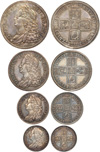 |
Great Britain. Proof Set, 1746. George II, 1727-60. Older Laureate Bust left. Reverse, crowned cruciform shields, angles plain. S-3690, 3696, 3704 and 3711; ESC-126, 608, 1208, 1619. These four coins are an excellent example of the very first Proof set issued by the Royal Mint specifically for collectors. Only about 100 such sets were made, the intended "market" being museums and aristocrats, for it was the vogue at the time for "gentlemen" to collect anything and everything related to "culture." The homeland coinage was therefore a natural item for inclusion in such gentlemens' holdings. This set consists of the four largest coins then in circulation, all struck as Proofs, as follows: the crown (S-3690) with VICESIMO edge inscription, the halfcrown (S-3696) with the same edge, and with engrailed edges the shilling (S-3704) and sixpence (S-3711). In 1746, the only silver coins of these denominations struck without the hallmark LIMA on them were these Proofs. It's not possible to say with certainty if these are the same four coins originally issued together as a set, but they match very well, as each has attractive silvery gray and gold iridescent toning, which is in fact brighter and prettier than is usually found on these coins. Very few sets remain intact: few original sets exist. Mostly what is seen today are individual coins, and the majority of the surviving specimens show a considerable amount of disturbance to the surfaces. This is one of the finest sets extant. Exceptionally choice Proofs, each blessed by the same iridescence, surface sparkle and originality. Lot of 4 coins. NGC graded Crown, Proof 65, Halfcrown NGC Proof-63, Shilling NGC Proof 64 and Sixpence NGC Proof-64.
Estimated Value $15,000 - 20,000.
Ex Dr Jacob Y. Terner Collection.
View details and enlarged photo
| Realized
$21,000 |
Lot 384 |
 |
Great Britain. "Lima" Crown, 1746. S-3689; Spink 3665; Dav-1350; KM-585.3. George II, 1727-1760. Old Head. DECIMO NONO on edge. Laureate, draped and cuirassed bust, left; LIMA below bust. Reverse: Crowned cruciform arms, nimbate cross at center. Sharply struck, with full mint luster beneath exquisite, long-set, deep bluish mauve toning. Scarce and historical, probably the finest known Lima crown. NGC graded MS-64.
Lima-hallmarked coins of the reign of George II were struck from the Spanish bullion seized by Captain George Anson under orders from the Admiralty during his trans-global ocean voyage of 1740-1744. When 11 Spanish treasure ships captured off the Philippines were sailed back to Portsmouth and the specie taken by wagon train along crowd-filled roads to the mint at London, England had effectively seized a huge fortune via legal piracy from the Spanish, who had mined the gold and silver at Lima, Peru. Soon after, Anson became the most renowned admiral of his day -- the most decorated and most honored. Entering the navy at 15, an officer at 21, and by 27 a captain with his own ship to command, Anson was given the fortunate charge in 1740 to circumnavigate the globe, penetrate the Straits of Magellan, stir the South American colonies into revolt, and generally raise as much pandemonium with the Spaniards and their shipping as he could. His six warships were at sea for three years and nine months. While his crews were beset by the inevitable scurvy, his squadron of ships endured storms, shipwreck and furious engagement at battle, costing him five of his command's six vessels, and some 1400 of his 1900 personnel! But he captured many prizes of booty, sacked and plundered the town of Payta Bay, sank or damaged a good number of Spanish ships, and most importantly captured the long-sought Spanish trading galleon La Nuestra Señora de Cavadonga, which had famously plied the Spanish shipping lanes between Acapulco and Manilla. This ship's cargo totaled some 36,000 ounces of silver, and a small amount of gold. In December of 1743, Anson turned towards home, arriving at the naval yards at Spithead (near Portsmouth) on June 15, 1744. Anson would eventually ascend to the rank of First Lord of the Admiralty, would be elevated to the peerage, and would use his influence to enact or oversee needed reforms to his beloved Royal Navy.
Estimated Value $10,000 - 12,500.
Once part of a presentation set (of four silver coins) reputedly given by Admiral Anson himself to the captain of one of his treasure ships and sold in a Spink Auction, London, mid-1980s. Illustrated in Money of The World, coin 106.
View details and enlarged photos
| Realized
$17,825 |
Lot 385 |
 |
Great Britain. Guinea, 1750. S-3680; Fr-344; KM-588. George II, 1727-1760. Old Laureate Head, left. Reverse: Crowned and garnished shield. Rare date in actuality, not that the standard references would so indicate. Among the finest known of its type, and possibly the very best 1750 in existence, despite the seemingly modest number grade. Sharp and beautiful! NGC graded MS-62.
Estimated Value $5,000 - 6,000.
Ex Dr Jacob Y. Terner Collection.
View details and enlarged photos
| Realized
$5,175 |
Lot 386 |
 |
Great Britain. Guinea, 1758. S-3680; Fr-344; KM-588. George II, 1727-1760. Old Laureate Head, left. Reverse: Crowned and garnished shield. A choice coin, boldly struck and very lustrous. NGC graded MS-63.
Estimated Value $3,000 - 3,500.
Ex Dr Jacob Y. Terner Collection.
View details and enlarged photos
| Realized
$4,255 |
Lot 387 |
 |
Great Britain. Guinea, 1760. S-3680; Fr-344; KM-588. George II, 1727-1760. Old Laureate Head, left. Reverse: Crowned and garnished shield. The final year, a choice coin with flashy luster. NGC graded MS-63.
Estimated Value $4,000 - 5,000.
Ex Dr Jacob Y. Terner Collection.
View details and enlarged photos
| Realized
$4,140 |
Lot 388 |
 |
Great Britain. Half Guinea, 1760. S-3685; Fr-349; KM-587. George II, 1727-1760. Old Laureate Head, left. Reverse: Crowned and garnished shield. Last year of issue for this type. A splendid, satiny coin, well struck from old dies, showing some crumbling around the reverse letters for instance, but glowing with luster, its surfaces nearly perfect! NGC graded MS-66.
Estimated Value $4,000 - 5,000.
Ex Dr Jacob Y. Terner Collection.
View details and enlarged photos
| Realized
$10,063 |
Lot 389 |
 |
Great Britain. Pattern Guinea, 1761. WR-82. DM-96. By Tanner. George III, 1760-1820. Plain laureate head right. Reverse: Crowned and garnished shield. Plain edge. This is R5, extremely rare (just 6 to 10 known). Any early George III guinea is most elusive, but a splendid cameoed pattern Proof such as this is even more so! Here, the king's portrait gleams with a special brilliance, seen on few other coins of any kind. NGC graded Proof 66 Ultra Cameo.
A gorgeous, striking design, with the curly hair reminding one of the splendid "Fine Work" guinea of William III, struck some sixty years earlier. Perhaps it was an inspiration for John Tanner, during this period when he and Richard Yeo were competing against each other's considerable talents for the king's pleasure (as well as that of the coinage committee). Patterns in gold reached new levels of beauty and technical proficiency in the 1760s and 1770s.
Estimated Value $10,000 - 12,000.
Ex Spink sale #96, lot 240. Ex Dr Jacob Y. Terner Collection.
View details and enlarged photos
| Realized
$25,300 |
Lot 390 |
 |
Great Britain. Pattern Guinea, 1761. WR-84. DM-97. George III, 1760-1820. Portrait by Yeo, the First Laureate Head, right (as adopted and used only in 1761). Plain edge. Reverse: Crowned and garnished shield. R4, very rare (11 to 20 known). This is among the rarest of all guinea types, and as a Proof it is even more special. In full brilliance, possessing lovely old-time reddish toning, moreso on its reverse. NGC graded Proof 63.
Estimated Value $10,000 - 12,000.
Ex Brooker (1971) and Selig collections; ex Spink sale of March 1909, lot 1112. Ex Dr Jacob Y. Terner Collection.
View details and enlarged photos
| Realized
$18,688 |
Lot 391 |
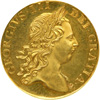 |
Great Britain. Proof Pattern Guinea, 1765. WR-88. DM-103 (this coin). George III, 1760-1820. Portrait by Yeo, the Intermediate Laureate Head, right. Reverse: Crowned and garnished shield. Plain edge. A brilliant and very choice specimen, with an impressive provenance. NGC graded Proof 64.
The suggested design, which became the 3rd Head, was first struck as a currency coin in 1765. This pattern is R5, extremely rare (6 to 10 known). It is one of two principal patterns for the Rose Guinea series which followed.
Estimated Value $12,000 - 15,000.
Ex Whetmore, Hewitt, Brooker, Douglas-Morris, and Selig collections. Ex Dr Jacob Y. Terner Collection.
View details and enlarged photos
| Realized
$18,975 |
Lot 392 |
 |
Great Britain. Rose Guinea, 1773. S-3727; Fr-354; KM-600. George III. Third Laureate Head, right. Reverse: Crowned and garnished shield. A most pleasing example from the last year of this charming type. NGC graded MS-63.
Estimated Value $1,500 - 2,000.
Ex Dr Jacob Y. Terner Collection.
View details and enlarged photos
| Realized
$3,105 |
Lot 393 |
 |
Great Britain. Pattern Rose Guinea in gold, 1774. WR-95. S-3728. By Pingo. George III, 1760-1820. Fourth Laureate Head, right. Reverse: Crowned and garnished shield. Plain, bevelled edge. A nice-looking Proof, but it has a faint scratch by the king's portrait in the obverse field. Rare. NGC graded Proof 62 Cameo.
Obviously a Specimen, struck to preserve an example of this new-portrait Rose Guinea for the various museums, to which it was sold by the Royal Mint. The die-bulge in the right reverse field is found on almost all examples.
Estimated Value $3,000 - 3,500.
Ex Dr Jacob Y. Terner Collection.
View details and enlarged photos
| Realized
$4,485 |
Lot 394 |
 |
Great Britain. Pattern Half Guinea, 1775. Type of S-3733. WR-129; DM-87. George III, 1760-1820. Portrait by Yeo, the Third Laureate Head, right. Reverse: Crowned and garnished shield. Plain edge. Excellent strike. Some very small abrasions on the face. NGC graded Proof 64.
This is a very rare (R3) Proof of Record showing the late bust of the king with long curls draped beneath the bust and a sort of melon-shaped head.
Estimated Value $6,000 - 7,000.
Ex Brooker and Selig collections. Ex Dr Jacob Y. Terner Collection.
View details and enlarged photos
| Realized
$10,350 |
Lot 395 |
 |
Great Britain. Rose Guinea, 1775. S-3728; Fr-355; KM-604. George III, 1760-1820. Fourth Laureate Head, right. Reverse: Crowned and garnished shield. A beautiful coin! Especially choice and boldly struck. Rare in this grade. NGC graded MS-63.
Estimated Value $2,000 - 2,500.
Ex Dr Jacob Y. Terner Collection.
View details and enlarged photos
| Realized
$3,335 |
Lot 396 |
 |
Great Britain. Rose Guinea, 1776. S-3728; Fr-355; KM-604. George III, 1760-1820. Fourth Laureate Head, right. Reverse: Crowned and garnished shield. Lustrous, well struck and problem free, therefore exceptional. This is a date in great demand from collectors tuned in to its connection with the American Colonies. NGC graded MS-62.
Estimated Value $1,250 - 1,500.
Ex Dr Jacob Y. Terner Collection.
View details and enlarged photos
| Realized
$4,140 |
Lot 397 |
 |
Great Britain. Rose Guinea, 1784. S-3728; Fr-355; KM-604. George III, 1760-1820. Fourth Laureate Head, right. Reverse: Crowned and garnished shield. A late-date Rose-style guinea possessing superb luster and wonderful surfaces, as sharp as these come in strike. NGC graded MS-64.
Estimated Value $1,500 - 1,750.
Ex Dr Jacob Y. Terner Collection.
View details and enlarged photos
| Realized
$3,565 |
Lot 398 |
 |
Great Britain. Rose Guinea, 1785. S-3728; Fr-355; KM-604. George III, 1760-1820. Fourth Laureate Head, right. Reverse: Crowned and garnished shield. Pleasing. Rarer than the catalogue value suggests, especially for a stunning grade such as this. NGC graded MS-64.
Estimated Value $1,500 - 1,750.
Ex Dr Jacob Y. Terner Collection.
View details and enlarged photos
| Realized
$3,680 |
Lot 399 |
 |
Great Britain. Proof Spade Guinea, 1787. S.3729; WR-104. "Plain border." George III, 1760-1820. Portrait by Pingo, the Fifth Laureate Head, right. Reverse: Crowned, spade-shaped shield. Plain edge. Especially choice and most desirable as a classic of the late 18th century. R3, very rare. One of the very finest extant! NGC graded Proof 65 Cameo.
168 Proofs were struck of Lewis Pingo's new design, including 100 given to directors of the Bank of England. The purpose was to preserve examples of the currency type first issued in this year.
Estimated Value $5,000 - 6,000.
Ex Dr Jacob Y. Terner Collection.
View details and enlarged photos
| Realized
$12,650 |
Lot 400 |
 |
Great Britain. Proof Half Guinea, 1787. S-3735; Fr-362; KM-608; W&R-130. George III, 1760-1820. Older, Fifth Laureate Head, right. Reverse: Crowned, spade-shaped shield. Plain edge. Very rare and especially fine for one of these, in fact a magnficient coin. NGC graded Proof 65 Cameo.
The prototype for this design by Lewis Pingo. This is the last of the half guineas, except for the Military type of the Napoleonic years.
Estimated Value $4,000 - 5,000.
Ex Dr Jacob Y. Terner Collection.
View details and enlarged photos
| Realized
$9,488 |
Lot 401 |
 |
Great Britain. Spade Guinea, 1788. S-3729; Fr-356; KM-609. George III, 1760-1820. Fifth Laureate Head, right. Reverse: Crowned, spade-shaped shield. Scarce in Mint State, for although common as a type most seen are circulated or suffered abuse. This is an exceptional example having most pleasing satiny luster and unusually fine fields. NGC graded MS-63.
The king's portrait was struck in lower relief beginning in this year, whereas the 1787 currency pieces are of higher relief and are therefore a separate sub-variety of this type.
Estimated Value $1,500 - 2,000.
Ex Dr Jacob Y. Terner Collection.
View details and enlarged photos
| Realized
$2,990 |
Lot 402 |
 |
Great Britain. Spade Guinea, 1790. S-3729; Fr-356; KM-609. George III, 1760-1820. Fifth Laureate Head, right. Reverse: Crowned, spade-shaped shield. A lovely, choice guinea. NGC graded MS-62.
Estimated Value $1,250 - 1,500.
Ex Dr Jacob Y. Terner Collection.
View details and enlarged photos
| Realized
$2,128 |
Lot 403 |
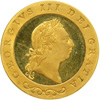 |
Great Britain. Pattern Guinea, 1791. WR-106. DM-114 (this coin). Struck in gold by Kuchler. George III, 1760-1820. Diminutive cameo portrait, set amid a mirror field offset by broad and heavily frosted borders inscripted with the legend. Reverse: Crowned, spade-shaped shield inside a similar broad border. Plain edge, thicker flan than normally used; struck using en medaille die alignment. R6: exceedingly rare: only a few (3 to 5) known in gold (some gilt also known). A marvelous, Choice brilliant Proof, with glossy fields and deeply frosted cameo devices and borders. NGC graded Proof 64 Ultra Cameo.
Estimated Value $10,000 - 12,000.
Ex Virgil Brand, Brooker, Douglas-Morris, and Selig collections. Ex Dr Jacob Y. Terner Collection.
View details and enlarged photos
| Realized
$18,688 |
Lot 404 |
 |
Great Britain. Spade Guinea, 1791. S-3729; Fr-356; KM-609. George III, 1760-1820. Fifth Laureate Head, right. Reverse: Crowned, spade-shaped shield. Another especially choice coin. A scarce date! NGC graded MS-64.
The Spade Guinea was conceived to circulate long among British and Prussian troops involved in the continuing war against Napoleon, and as such its engraving was done in low relief. This served the purpose well, but the coin as a type has long proved difficult to grade for many collectors, who mistake its lack of deep detail for wear. The grading companies have likewise had their troubles assessing these consistently. Here is one of the highest number grades given out to date for any guinea of this style.
Estimated Value $1,500 - 2,000.
Ex Dr Jacob Y. Terner Collection.
View details and enlarged photos
| Realized
$3,795 |
Lot 405 |
 |
Great Britain. Spade Guinea, 1793. S-3729; Fr-356; KM-609. George III, 1760-1820. Fifth Laureate Head, right. Reverse: Crowned, spade-shaped shield. An exceptionally choice, flashy coin. Rare grade. NGC graded MS-63.
Estimated Value $1,250 - 1,500.
Ex Dr Jacob Y. Terner Collection.
View details and enlarged photos
| Realized
$2,300 |
Lot 406 |
 |
Great Britain. Spade Guinea, 1794. S-3729; Fr-356; KM-609. George III, 1760-1820. Fifth Laureate Head, right. Reverse: Crowned, spade-shaped shield. Choice Uncirculated with prooflike qualities, which are unusual. Rare date and grade. NGC graded MS-63.
Estimated Value $1,250 - 1,500.
Ex Dr Jacob Y. Terner Collection.
View details and enlarged photos
| Realized
$2,415 |
Lot 407 |
 |
Great Britain. Spade Guinea, 1797. S-3729; Fr-356; KM-609. George III, 1760-1820. Fifth Laureate Head, right. Reverse: Crowned, spade-shaped shield. Lustrous and truly choice, and as such quite rare. NGC graded MS-64.
Estimated Value $1,500 - 2,000.
Ex Dr Jacob Y. Terner Collection.
View details and enlarged photos
| Realized
$3,910 |
Lot 408 |
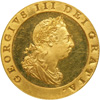 |
Great Britain. Pattern Guinea in gold, 1798. WR-110. DM-116. Design by Kuchler. George III, 1760-1820. Soho Mint style with broad rims and a cameo appearance, similar to the 1791 pattern in this collection, but on a thin flan. Stop after GRATIA. R6, extremely rare (only 3 to 5 known). A very choice, brilliant cameo Proof. NGC graded Proof 63 Ultra Cameo.
Estimated Value $8,000 - 10,000.
Ex Herman Selig Collection. Ex Dr Jacob Y. Terner Collection.
View details and enlarged photos
| Realized
$17,538 |
Lot 409 |
 |
Great Britain. Spade Guinea, 1799. S-3729. George III, 1760-1820. Fifth Laureate Head, right. Reverse: Crowned, spade-shaped shield. The rarest and last date of this type. Late die state (minor "crumbling" or die rust around some letters). An impressive guinea, boldly struck with gleaming luster! NGC graded MS-65.
Estimated Value $2,000 - 2,500.
Ex Dr Jacob Y. Terner Collection.
View details and enlarged photos
| Realized
$5,290 |
Lot 410 |
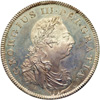 |
Great Britain. Pattern Garter Dollar, 1804. ESC-182. KM-Pn66; Davis-21. Plain edge. Silver. C.H.K. on truncation. George III, 1760-1820. George III, bust right. Reverse: Crowned garter shield. Bright mirror fields, the obverse legend handsomely outlined in dark-blue toning, while the reverse shows a delightful light golden green iridescence. A premium example! Very rare. NGC graded Proof 66.
Struck over a Spanish Colonial 8 Reales of Charles IV. The undertype coin is clearly evident, as part of the Spanish titles show in "shadow," generally near the rims. All garter dollars were emergency issues and almost all were struck over earlier coins, most often Spanish 8 Reales, which accounts for the oft-seen rough planchets and other irregularities on the surfaces of the new coins.
Estimated Value $5,000 - 6,000.
View details and enlarged photos
| Realized
$16,100 |
Lot 411 |
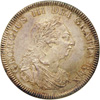 |
Great Britain. Bank of England Dollar (5 Shillings), 1804. S-3768; Dav-101; Cr-41. Plain edge. George III, 1760-1820. Laureate, draped and cuirassed bust, right. Reverse: Britannica seated left, holding branch and shield, with shield resting on cornucopia, beehive at left; all within Garter frame surmounted by mural crown. A gem coin, sharply struck with lustrous fields beneath lightly iridescent gold and russet toning. Rare in this condition. NGC graded MS-65.
Britain's continuing conflicts with France and Spain in the 18th century seriously impinged on the flow of silver, mostly in the form of Mexican and Peruvian dollars (8 reales), into the country. This drove up the price of silver within England, which encouraged hoarding, which in turn further exacerbated her silver famine. The silver crisis finally was reversed by the end of the century when the foreign dollars once more poured into Britain. However, their price was still too high for them to be recoined along old English monetary standards. Thus they were allowed to circulate as they were, some being countermarked by industrial companies at a revalued rate. Meanwhile, quantities began to accumulate in the Bank of England's vaults, where they were being held as bullion. Propping up bank reserves didn't help ameliorate the pinch still felt in public commerce. Eventually by 1797, the government saw fit to initiate its own countermarking program, with the Spanish reales marked at an official rate of 4 shillings, 9 pence. The coins bore a countermarked portrait of George III stamped over the face of Spain's Charles IV. The new issues were accepted by the public with reluctance, and prompted the quip "The Bank, to make their Spanish dollars pass, stamped the head of a fool on the neck of an ass." Finally in 1804, when the Napoleonic Wars were once more constricting silver availability, the Bank of England was authorized to overstrike the Spanish dollars, giving them a rate of 5 shillings. The new coins, a token coinage in actuality, were produced on Boulton and Watt's new steam-operated presses at the Soho Mint, Birmingham. The strength of the striking was such that the original Spanish designs were fairly well obliterated. To enhance public acceptance, the reverse sported a new patriotic design of a seated Britannia flanked by a beehive (a symbol of industriousness) and a cornucopia (standing for abundance, or prosperity). A classic was born!
Estimated Value $2,000 - 2,500.
View details and enlarged photos
| Realized
$3,360 |
Lot 412 |
 |
Great Britain. Silver Proof Twopence, 1805 (Soho Mint). Peck-1312: rated "exceedingly rare" by Peck; only 3 or 4 known! Linecar & Stone-24 (also as similarly rare). George III, 1760-1820. Laureate, draped bust of George right. Reverse: Britannia seated left on rocks, holding branch and trident; at left, small ship on horizon. Impeccable strike; a few light contact marks on reverse figure. Nevertheless this is most probably the finest known example of this great rarity, exhibiting glorious toning in blue, green, silver and gold iridescent hues. The eye appeal of this specimen is off the charts. NGC graded Proof 66 Cameo.
Estimated Value $14,000 - 15,000.
Ex Dr Jacob Y. Terner Collection.
View details and enlarged photos
| Realized
$24,150 |
Lot 413 |
 |
Great Britain. Bank of England Pattern Five Shillings & Sixpence, 1811. ESC-194A, type of C/4. By C. H. Kuchler. Thick flan, 36.79 grams. George III, 1760-1820. Laureate, draped and cuirassed bust right, with designer's initials at the truncation as "C.H.K." Reverse: Seated Britannia left, holding spear, while left arm rests on shield. Sharply struck with frosted devices on almost flawless mirror fields. This lovely specimen is beautifully toned in old-time multicolor iridescence that only careful handling, correct storage conditions, and a time span of almost two centuries can produce. The eye appeal is, again, as with the preceding piece, phenomenal. Interestingly, evidence of light die rust can be seen on Britannia. NGC graded Proof 67 Cameo.
Estimated Value $25,000 - 30,000.
Ex Boulton Family. Rated in ESC as R7, "only one or two examples known." In fact there are two and this is the finest by far. The other known example weighs 36.67 grams and was offered in a 1989 Spink Tokyo auction estimated at 32,000,000 Yen (US $30,000). Semi-Unique and of the greatest importance to the British series.
View details and enlarged photos
| Realized
$60,375 |
Lot 414 |
 |
Great Britain. Pattern Military Guinea, 1813. WR-119. DM-122 (this coin is superior to D-M's). By Thomas Wyon. Reeded edge. George III, 1760-1820. Older, portly, laureate head right. Reverse: Crowned shield garnished with rose, thistle and clover. Struck en medaille. R6, extremely rare (just 3 to 5 known, including those impounded in museums). This specimen is exceptionally choice for proofs or patterns of this period in history, with brilliant mirrors, the cameo portrait and other devices beautifully frosted, producing strong contrast. NGC graded Proof 63 Cameo.
Four kinds of reverse designs were executed in gold for the various patterns of the Military Guinea. This one features an elegant crowned shield with sprays of rose, thistle and shamrock at the base. The wonderful, Caesar-like portrait is signed "W" clearly in the field below the truncation of the king's neck, for William Wyon, the Royal Mint's chief engraver and the artist responsible for this magnificent coin.
Estimated Value $12,500 - 15,000.
Ex Plumbridge Collection. Ex Dr Jacob Y. Terner Collection.
View details and enlarged photos
| Realized
$24,150 |
Lot 415 |
 |
Great Britain. Proof Military Guinea, 1813. WR-114. S-3730; Fr-357; KM-664. George III, 1760-1820. 6th Laureate (Military) Head. Older, portly portrait, right. Reverse: Crowned garter supporting shield. Reeded (curved graining) edge. R4, very rare (11 to 20 known). Seldom seen in any state, let alone this splendid grade. Choice with a cameo portrait. NGC graded Proof 64 Cameo.
Proof of Record for the currency issue of this year. The commercial version of these coins was intended to pay British troops abroad who were fighting Napoleon's armies.
Estimated Value $8,000 - 10,000.
Ex Dr Jacob Y. Terner Collection.
View details and enlarged photos
| Realized
$18,400 |
Lot 416 |
 |
Great Britain. Proof Sovereign, 1817. S-3785; WR-197; Fr-371; KM-674. George III, 1760-1820. New Coinage. Older, laureate head right. Reverse: St George and the Dragon, frosted against a mirrored field, all set within an inscribed border composed of the royal garter, frosted. Legend type A; reeded edge. R5, extremely rare: 6 to 10 listed as known by Wilson & Rasmussen; this is a bit of an exaggeration; nonetheless, this piece is among the finest extant, or seen in at least two decades of searching by its former owner-collector (Dr Terner), and there are probably in fact perhaps 20 known, including those impounded in museum collections. All in all, here for your bidding pleasure is a truly rare and splendid, deeply mirrored, cameo Proof which would be difficult if not impossible to locate any finer. NGC graded Proof 63 Cameo.
A Proof of Record, struck to preserve examples for museum collections. The new sovereign, valued at 20 shillings, which replaced the venerable guinea, was introduced in this year, 1817, and was coined using the steam-powered minting presses devised by Boulton and Watt for their Soho Mint, and sold to the Crown for use in its new Tower Hill Mint shortly after the turn of the century. The "Great Recoining" introduced new, more technically profound versions of all denominations beginning in the year 1816 for silver and 1817 for gold. The gold sovereign was the largest and most precious circulating coin of the realm, and here is an ideal coin to represent that monumental development in monetary standards, design, and minting efficiency.
Estimated Value $9,000 - 10,000.
Ex Dr Jacob Y. Terner Collection.
View details and enlarged photos
| Realized
$16,800 |
Lot 417 |
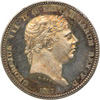 |
Great Britain. 'Three Graces' Pattern Crown, 1817. ESC-223. By William Wyon. Silver. George III, 1760-1820. Laureate Head right. Reverse: Three wreathed women standing together, holding hands, representing from left to right Ireland, England and Scotland, their attributes of harp, shield and thistle at their feet; in exergue, quiver and palm branch; legend FOEDUS INVIOLABILE. Plain edge. Choice glassy fields beneath iridescent russet and deep gold toning, with the king's portrait frosted and in contrast against the mirrored field, the same effect produced on the reverse motif. Especially fine for issue, lacking the typically seen heavy hairlines and rubbed-away metal on the high points of the designs, the Graces showing only the slightest "cabinet friction" on the high points. Very rare, but this is beyond that level, as one of the finest known of few minted. NGC graded Proof 64 Cameo.
In terms of rarity and desirability, the Three Graces crown should be considered the English equivalent to George Morgan's always sought-after "Schoolgirl" silver dollar pattern of 1879 in the U.S. series. It is one of England's most artistic coins.
Estimated Value $10,000 - 12,500.
Ex Spink Auction (4/75), lot 1187.
View details and enlarged photos
| Realized
$36,800 |
Lot 418 |
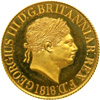 |
Great Britain. Proof Sovereign, 1818. S-3785A; WR-198; Fr-371; KM-674. New Coinage. George III, 1760-1820. Older, Laureate Head right. Reverse: St George and the Dragon. Legend type B; reeded edge. Another Proof of Record, but far rarer! R6, extremely rare (just 3 to 5 known, according to Wilson & Rasmussen, and this seems an accurate appraisal). Dr Terner searched for years for a spectacular cameo Proof, and this was the piece he settled upon; it was purchased by the present owner in our sale of his collection several years ago. NGC graded Proof 64 Ultra Cameo.
Around the time of the commencement of England's recoinage, the art world was caught up in the artistic movement known as Neoclassicism. One of the most influential patrons of this type of contemporary Italian art was the Prince Regent, later George IV of England. It was because of his taste, and through his influence, that an Italian medallist and cameo engraver named Benedetto Pistrucci was appointed to the Mint to design and engrave new dies for the Great Recoinage. He produced a series of busts of the aged George III which were certainly the equal of the Napoleonic imperial portaits, and yet it was for the reverses of the crown and the new sovereign that his laurels were earned. His conception of Saint George and the Dragon was monumental. It was one of the most successful coin designs of its time, and remains so to this day. His original rendering of Saint George was a carved hardstone cameo shown to officials at the Royal Mint, and it was they who directed that a small number of Proofs should be struck to preserve these classics of design for future generations.
Estimated Value $12,000 - 15,000.
Ex Sharps-Pixley and Terner Collections. Ex Dr Jacob Y. Terner Collection. Illustrated in Money of The World, coin 142.
View details and enlarged photos
| Realized
$26,450 |
Lot 419 |
 |
Great Britain. Crown, 1818. S-3787; C-34. George III, 1760-1820. New Coinage of 1816-1820, with Benedetto Pistrucci's designs. Laureate Head right. Reverse: St George and the Dragon, within garter border. LIX edge. Extraordinarily sharp strike, with clean prooflike fields, and superb old toning, deepset with a pastel quality but somewhat iridescent, ranging from russet gray to steel blue. The quality of the strike, along with its pristine condition, would well support the notion of this coin being a presentation piece. Seems conservatively graded, as this is one of the finest ever seen of its type. NGC graded MS-65.
Estimated Value $3,000 - 3,500.
View details and enlarged photos
| Realized
$4,025 |
Lot 420 |
 |
Great Britain. Pattern Silver Crown, ND (1820). ESC-221; KM-PnB80. George III, 1760-1820. Webb & Mills. Laureate Head right. Reverse: Crowned cruciform arms, St George and the Dragon within garter at center; rose, shamrock, thistle and rearing horse in angles. Plain edge. A truly superb and stunningly toned specimen -- the strike impeccable, the surfaces shimmering in bluish green and gold iridescence. NGC graded Proof 64.
Interesting idealized sculptural portrait of the king in laurels. Crowther points out that the reverse emblems are the English rose, Irish shamrock, Hanover horse and Scots thistle, with a tiny Saint George garter in the center. Linecar and Stone explain that Thomas Webb designed the portrait, and George Mills the distinctive cruciform reverse, as commissioned by James Mudie, famous for his medals commemorating British victories. Scarce, but never popular, perhaps this curious piece deserves some reconsideration as a tribute to a dying king, for it must have been made just as George III was drawing his last breaths.
Estimated Value $2,500 - 3,000.
Ex Cheshire Collection (5/30 - 6/1/05), lot 2529.
View details and enlarged photos
| Realized
$4,888 |
Lot 421 |
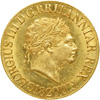 |
Great Britain. Gold Sovereign, 1820. S- 3785C; Fr-371; KM-674. George III, 1760-1820. New Coinage. Older, Laureate Head right. Reverse: St George and the Dragon, within inscribed border comprised of garter. Legend type B; large open date; reeded edge. A choice and frosty Uncirculated coin, with far fewer abrasions than typically seen. Harsh numerical grade. Elusive. NGC graded MS-62.
Estimated Value $2,000 - 2,500.
Ex Dr Jacob Y. Terner Collection.
View details and enlarged photos
| Realized
$2,415 |
Lot 422 |
 |
Great Britain. Sovereign, 1821. S-3800; WR-231; Fr-376; KM-682. George IV, 1820-1830. Plump, Laureate Head left. Reverse: St George and the Dragon, date below. Reeded edge. R3, very rare. Struck for inclusion in the Coronation Proof sets of this year, one of the rarest such sets of the past two centuries. A lovely cameo specimen with beautiful golden red surfaces. One of the finest extant! NGC graded Proof 64 Ultra Cameo.
Estimated Value $12,000 - 14,000.
Ex Norweb Collection. Ex Dr Jacob Y. Terner Collection.
View details and enlarged photos
| Realized
$14,375 |
|
|